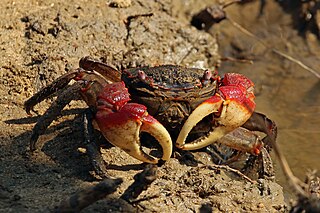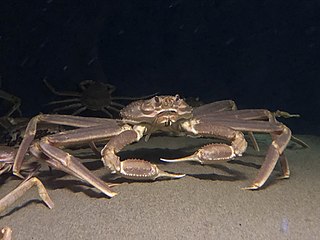
The Japanese spider crab is a species of marine crab and is the biggest one that lives in the waters around Japan. At around 3.7 meters, it has the largest leg-span of any arthropod. The Japanese name for this species is taka-ashi-gani,, literally translating to “tall legs crab”. It goes through three main larval stages along with a prezoeal stage to grow to its great size.

Cancer pagurus, commonly known as the edible crab or brown crab, is a species of crab found in the North Sea, North Atlantic Ocean, and perhaps the Mediterranean Sea. It is a robust crab of a reddish-brown colour, having an oval carapace with a characteristic "pie crust" edge and black tips to the claws. A mature adult may have a carapace width up to 25 centimetres and weigh up to 3 kilograms. C. pagurus is a nocturnal predator, targeting a range of molluscs and crustaceans. It is the subject of the largest crab fishery in Western Europe, centred on the coasts of the British Isles, with more than 60,000 tonnes caught annually.

The Tasmanian giant crab, also known as the giant deepwater crab, giant southern crab, queen crab, or bullcrab, is a very large species of crab that resides on rocky and muddy bottoms in the oceans off Southern Australia. It is the only extant species in the genus Pseudocarcinus.

Cancer is a genus of marine crabs in the family Cancridae. It includes eight extant species and three extinct species, including familiar crabs of the littoral zone, such as the European edible crab, the Jonah crab and the red rock crab. It is thought to have evolved from related genera in the Pacific Ocean in the Miocene.

Carcinus is a genus of crabs, which includes Carcinus maenas, an important invasive species, and C. aestuarii, a species endemic to the Mediterranean Sea.

Leptuca pugilator, the sand fiddler crab, Atlantic sand fiddler crab, or Calico fiddler, is a species of fiddler crab that is found from Massachusetts to the Gulf of Mexico. It lives in burrows in coastal and estuarine mud-flats, and can be extremely abundant. It can be differentiated from the morphologically similar Minuca pugnax and Minuca minax by the smoothness of the inside of its claws. One claw is larger than the other, and can be much larger than the crab's body, at up to 41 mm (1.6 in) long.

The Sesarmidae are a family of crabs, previously included in the Grapsidae by many authors. Several species, namely in Geosesarma, Metopaulias, and Sesarma, are true terrestrial crabs. They do not need to return to the sea even for breeding.

Chiromantes dehaani is a mudflat crab of the Sesarmidae family, which is endemic to East Asia. It typically lives in mangrove swamps and is known under the common name kurobenkeigani in Japan. C. dehaani has an uneven carapace, which is divided into four frontal lobes. Its walking legs are covered with thick, long setae (hairs), while the palm surfaces of its rough, granular chelipeds (claws) contain tubercules.

Metacarcinus is a genus of crabs formerly included in the genus Cancer. It includes nine exclusively fossil species and five extant species, of which four are also known from the fossil record. A molecular study using the cytochrome oxidase I gene does not support the monophyly of this genus.

Pilumnus hirtellus, the bristly crab or hairy crab, is a species of European crab. It is less than 1 inch (25 mm) long and covered in hair. It lives in shallow water and feeds on carrion.

Maguimithrax spinosissimus, also known as the Caribbean king crab, West Indian spider crab, channel clinging crab, reef or spiny spider crab, and coral crab, is a species of spider crab that occurs throughout South Florida and across the Caribbean Islands.

Heloecius cordiformis is a species of semiterrestrial crab found in mangrove swamps and mudflats along the east coast of Australia. Adults are around 25 mm (1 in) wide, with males being larger and having larger and more conspicuously coloured claws. The males wave their claws to communicate with other crabs, giving them their common name of semaphore crab. They can breathe both in air and under water, and feed at low tide on detritus in the sediment. H. cordiformis is the only species in the genus Heloecius and the family Heloeciidae.

Chionoecetes opilio, a species of snow crab, also known as opilio crab or opies, is a predominantly epifaunal crustacean native to shelf depths in the northwest Atlantic Ocean and north Pacific Ocean. It is a well-known commercial species of Chionoecetes, often caught with traps or by trawling. Seven species are in the genus Chionoecetes, all of which bear the name "snow crab". C. opilio is related to C. bairdi, commonly known as the tanner crab, and other crab species found in the cold, northern oceans.

Guinotellus melvillensis is a species of crabs in the family Xanthidae, the only species in the genus Guinotellus. It is a benthic crab with an ovate carapace within the subfamily Euxanthinae.

Carpilius maculatus, common names seven-eleven crab, spotted reef crab, dark-finger coral crab, and large spotted crab, is a species of crab in the family Carpiliidae, which also includes C. convexus and C. corallinus. While there have reports of the C. maculatus as being poisonous, biochemical testing has revealed that they lack any paralytic shellfish toxins.

Calappa calappa, also known as the smooth box crab or red-spotted box crab, is a tropical marine species of crab with an Indo-Pacific distribution, and showing great variability in its patterning and colouration. First described as Cancer calappa by Linnaeus in 1758 from a specimen originating from Ambon Island, and later in 1781 as Cancer fornicatus by Fabricius, it was finally placed in the genus Calappa by Lancelot Alexander Borradaile in 1903. The name calappa is associated with kelapa, the Malay word for 'coconut'.

Tubuca polita, commonly known as the polished fiddler crab. or pink-clawed fiddler crab is a species of fiddler crab that is found in the northern part of Australia including the Torres Strait Islands

Tubuca coarctata is a species of fiddler crab found in the western Pacific ocean, including Japan, Taiwan, the Philippines, Indonesia, New Guinea and Australia. The common name of these crabs is either the compressed fiddler crab, or the orange-clawed fiddler crab,. They are found on tidal mud flats adjacent mangroves and muddy tidal creek and river banks.

Tubuca dussumieri, is a species of fiddler crab that is found in the western and south pacific including New Caledonia, Indonesia, Malaysia, Taiwan, Japan, north eastern Australia

Parasesarma messa, commonly known as the maroon mangrove crab, is a species of burrowing crab found in Queensland, Australia. It lives in mangroves in estuaries and sheltered bays. It was originally described as Sesarma messa, but was placed in the genus Parasesarma in 2017. Perisesarma messa is also a synonym.




















